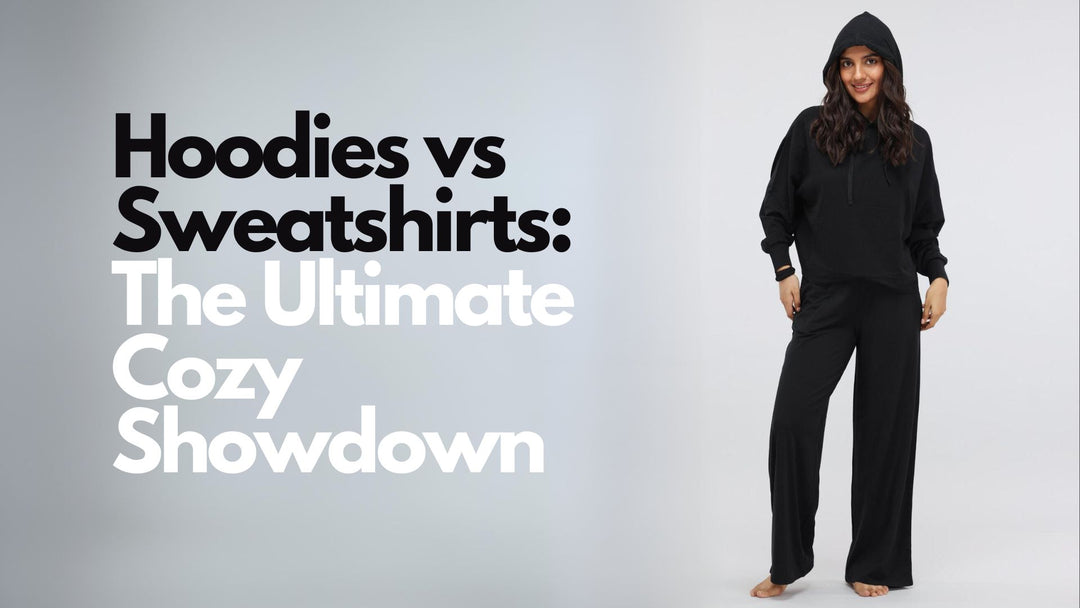Choosing between a fleece hoodie and a cotton hoodie isn’t just about style—it’s about how the fabric aligns with your lifestyle. Fleece offers winter-ready warmth, while cotton delivers breathable comfort. Let’s break down their strengths to help you pick the best hoodie material for your needs.
Comfort & Warmth: The Cozy Factor
Fleece Hoodies
Fleece is the go-to fabric for cold climates. Made from polyester, it traps heat efficiently while remaining lightweight. Its brushed interior feels plush against the skin, making it ideal for:
-
Winter layering
-
Outdoor workouts
-
Travel in chilly weather
Cotton Hoodies
Cotton’s natural fibers prioritize breathability, making it perfect for everyday wear. It’s softer over time and gentle on sensitive skin. Opt for cotton if you want:
-
All-day comfort in mild weather
-
A hypoallergenic fabric
-
A casual, relaxed look
Try NeceSera’s Grey Cotton Terry Sweatshirt for a buttery-soft feel that works year-round.
Durability & Care: Longevity Matters
Fleece
-
Pros: Resists wrinkles, retains color after washing, and dries quickly.
-
Cons: May pill over time if not washed gently.
Cotton
-
Pros: Ages gracefully, becoming softer with each wash. Organic cotton (like NeceSera’s Supima Cotton Range) is eco-friendly.
-
Cons: Can shrink if machine-dried; less insulating when wet.
|
Fabric |
Wash Care Tips |
Lifespan |
|
Fleece |
Cold wash, air-dry |
3–5 years |
|
Cotton |
Mild detergent, low-heat dry |
5+ years |
Pricing Analysis: Budget vs. Investment
-
Fleece: Generally affordable (₹1,000–₹2,500). Synthetic production keeps costs low.
-
Cotton: Pricier due to natural fibers (₹1,500–₹4,000). Organic options cost 20–30% more.
NeceSera balances quality and value, offering fleece and cotton hoodies like the Cotton Terry Hoodie that blend luxury with practicality.
Also read - Hoodies vs Sweatshirts
Environmental Impact: Sustainability Considerations
When choosing between fleece and cotton hoodies, it's important to consider their environmental impact:
Fleece
-
Made from synthetic materials, often derived from petroleum
-
Can shed microplastics during washing, contributing to water pollution
-
Some brands now offer fleece made from recycled plastic bottles
Cotton
-
Natural, biodegradable fiber
-
Conventional cotton farming uses significant water and pesticides
-
Organic cotton (like NeceSera's Supima Cotton Range) reduces environmental impact
Eco-Friendly Options:
-
Look for recycled polyester fleece or organic cotton certifications
-
Consider the garment's lifespan and how often you'll need to replace it
-
NeceSera's commitment to sustainability includes using organic cotton and exploring recycled materials for fleece options
Moisture Management: Staying Dry and Comfortable
How each fabric handles moisture can greatly impact your comfort:
Fleece
-
Wicks moisture away from the skin quickly
-
Retains insulating properties even when damp
-
Dries faster than cotton, making it ideal for active use
Cotton
-
Absorbs moisture well, keeping you cool in warm weather
-
Can feel heavy and lose insulating properties when wet
-
Takes longer to dry, which can be uncomfortable in cold conditions
Pro Tip: For activities where you expect to sweat, NeceSera's moisture-wicking fleece options provide superior comfort and performance.
Layering Potential: Versatility in Your Wardrobe
Both fleece and cotton hoodies can play different roles in a layered outfit:
Fleece
-
Works well as a mid-layer under a waterproof shell
-
Lightweight options can be worn as a base layer
-
Bulkier fleece can serve as an outer layer in dry, cold conditions
Cotton
-
Excellent as a comfortable base layer in mild weather
-
Can be layered under jackets or coats for added warmth
-
Looser fits allow for layering underneath in cooler temperatures
Styling Tip: NeceSera's Cotton Terry Hoodie is designed with layering in mind, fitting comfortably under jackets or over t-shirts for year-round versatility.
Allergies and Skin Sensitivities: Choosing for Comfort
For those with sensitive skin or allergies, fabric choice is crucial:
Fleece
-
Hypoallergenic and less likely to irritate skin
-
Can cause static electricity, which some find uncomfortable
-
May trap heat and cause sweating in sensitive individuals
Cotton
-
Natural fibers are gentle on most skin types
-
Breathable, reducing the risk of skin irritation from overheating
-
Organic cotton (like in NeceSera's collections) minimizes exposure to irritating chemicals
Health Tip: If you have sensitive skin, try NeceSera's organic cotton options for the most comfortable and skin-friendly choice.
Travel-Friendly Features: Packing Smart
When choosing a hoodie for travel, consider these factors:
Fleece
-
Lightweight and compressible, taking up less space in luggage
-
Wrinkle-resistant, maintaining appearance after being packed
-
Quick-drying if you need to wash on the go
Cotton
-
May wrinkle more easily when packed
-
Heavier than fleece, potentially impacting luggage weight
-
Versatile for various climates and activities
Travel Hack: NeceSera's packable fleece options are designed to fold into their own pockets, saving valuable suitcase space.
Customization and Personalization: Making It Yours
Both fleece and cotton hoodies offer different opportunities for customization:
Fleece
-
Takes well to embroidery and appliqué
-
Can be difficult to screen print due to texture
-
Often available in vibrant colors due to synthetic dyes
Cotton
-
Ideal for screen printing and heat transfer designs
-
Absorbs fabric dyes well for custom coloring
-
Can be easily tie-dyed for a unique look
Personalization Option: NeceSera offers customization services for both fleece and cotton hoodies, allowing you to add personal touches to your favorite styles.
Conclusion: Match the Fabric to Your Lifestyle
Choose fleece for skiing, camping, or chilly mornings.
Pick cotton for daily wear, sensitive skin, or eco-conscious choices.
For transitional styles that work in any season, explore NeceSera’s Cotton Terry Collection, designed to adapt to your routine—whether you’re working out or winding down.
FAQs
1. Which hoodie is better for winter: fleece or cotton?
Fleece wins for insulation. Its synthetic fibers trap heat better than cotton.
2. Are fleece hoodies good for workouts?
Yes! Fleece wicks sweat faster and dries in half the time of cotton.
3. What should I check when buying a hoodie?
-
Climate suitability
-
Fabric weight (lightweight vs. heavyweight)
-
Care instructions
4. How do I prevent cotton hoodies from shrinking?
Wash in cold water and air-dry.
5. Which fabric is more sustainable?
Organic cotton (used in NeceSera’s collections) has a lower environmental impact than conventional fleece. Final Tip: For hoodies that transition from workouts to weekends, try NeceSera’s Rhea X NeceSera Collaboration, crafted with patented Luxflo fabric for unmatched softness.







